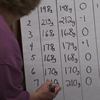What happens to weight and volume when water freezes?
4. Make meaning
Classroom Case


Data
The Role of Data Discussions
Available online at inquiryproject.terc.edu
The class table now holds weight and volume data for (12) bottles. That data includes: weight before freezing; weight after freezing; and information about volume.
Purpose of the discussion
The purpose of this discussion is for students to connect the investigation question with the weight and volume data they have collected by making claims and describing the supporting evidence.
Engage students in the focus question
Based on the data we have collected, what can we claim about weight and volume when water freezes? Let's start with volume.
Volume
Class data will very likely justify a claim that volume increases when water freezes.
- What can we claim about volume? What evidence supports this claim?
- How do your predictions compare with the classroom data?
- Have you noticed other situations in which the volume of water expands when it freezes?
- water bulging over the top of the ice cube tray
- hoses expanding or bursting when left outside in freezing weather
Note: Although the actual weight of the water in the bottles does not change during freezing, it's unlikely that the weight measurement will remain the same for every pair in the classroom, due to the limitations of the scales or other sources of error. Students may think that since the volume of water has increased, the weight must also increase.
Weight
- What can we claim about weight? What evidence supports this claim?
- How do your predictions compare with the classroom data?
If every pair reports no weight change, you can skip the question below.
- The scales round to the nearest gram and are not the most accurate scales. A one-gram difference might be explained by a scale giving different readings, so we can assume the weight stayed the same.
- No matter was added to or removed from the inside of the container once it was covered, so the amount of matter inside the container has not changed.
- Condensation adds new matter to the outside of the container, so if someone did not completely remove the condensation, this might explain a small increase in the weight, but the weight of water inside stayed the same.
Save the frozen containers. Students will weigh and measure them again in the next class, after the ice has completely melted. Since the containers are sealed, evaporation will not influence the results.
Summarize the discussion and recap the investigation
Using the same language students have used, summarize their main ideas.
Include the following key ideas:
- The volume of a sample of water increases when it is frozen.
- The weight of a sample of water remains the same when it is frozen.
- (Include if appropriate) Reasoning tells us that small changes in the weight of a sample are due to an error of some type. (rounding or reading error.)
- Highlight the idea that weight is the measure of the amount of matter, the amount of stuff, so when there is no change in the amount of matter-no one added more water to the bottle or removed water from the bottle-then we should expect no change in the weight.
- Remind students that when they dissolved salt in water and the salt was no longer visible, it was weight that convinced us that the salt was still there.
As you recap the investigation, be sure there is understanding of these points:
- The class collected and shared weight and volume data for the samples of frozen water.
- The data allowed the class to answer the investigation question, What happens to weight and volume when water freezes?
- We learned that the weight of a water sample remains the same even when volume increases.
- Since reasoning—as well as most of the data—tells us that the weight of water does not change when no water is added or removed, we conclude that a small change in the weight of a sample is due to rounding or possibly a recording error.



